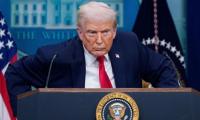Fund expresses optimism on Pakistan’s economy, projects 5 percent growth for 2017
KARACHI: The International Monetary Fund (IMF) on Tuesday reiterated its optimism on Pakistan’s economy, foreseeing an uptick in growth as investment has increased to reduce infrastructure spending gap.
“In Pakistan, a broad-based recovery is expected to continue at a healthy pace, with growth forecast at 5 percent in 2017 and 5.2 percent in 2018, supported by ramped-up infrastructure investment,” the IMF said in its World Economic Outlook (WEO), which was unveiled before the start of the annual spring meeting of the Fund and the World Bank. The growth forecasts were more or less the same as that of the World Bank and Asian Development Bank (ADB), while the government also expected the country’s GDP growth at 5 percent for the current fiscal year of 2016/17 as against 4.7 percent in 2015/16.
Both the ADB and World Bank projected the country’s growth at 5.2 percent in 2017 and 5.5 percent in 2018. The Fund suggested that the consumer price inflation has bottomed out as it revised up its inflation forecast for the country to 4.3 percent in 2017 and five percent in 2018 as compared to 2.9 percent in 2016. It further projected the country's current account deficit at 2.9 percent in 2017 and 3.0 percent in 2018. The deficit would be on the upward trend as compared to 1.1 percent in 2016.
Unemployment rate would be the same 6.0 percent in 2017 as in 2016, according to the IMF’s data. It, however, revised up its unemployment rate forecast for the country at 6.1 percent in 2018. The IMF said lower oil prices would hamper the regional growth. “The near-term outlook for the Middle East, North Africa, Afghanistan and Pakistan region has weakened, with growth forecast to be 2.6 percent in 2017, 0.8 percentage point lower than projected in the October 2016 WEO.”
But, Pakistan would witness the highest growth during the two-year period among all the oil importing and exporting countries in the region, including Egypt, Morocco, Sudan, Tunisia, Lebanon, Jordan, Saudi Arabia, Iran, UAE, Algeria, Iraq, Qatar and Kuwait. The IMF predicted that the global economic growth would clock in at 3.5 percent in 2017 as compared to 3.1 percent in 2016, while for 2018, the GDP growth was projected at 3.6 percent. The Fund foresaw a recovery in global demand, subdued deflationary pressures and improved financial markets.
“But structural impediments to a stronger recovery and a balance of risks that remain tilted to the downside, especially over the medium term, remain important challenges,” it said. “Emerging market and developing economies… now account for more than 75 percent of global growth in output and consumption, almost double the share of just two decades ago.”
-
 Alexander Skarsgard Breaks Silence On Rumors He Is Bisexual
Alexander Skarsgard Breaks Silence On Rumors He Is Bisexual -
 King Charles Faces Rift With Prince William Over Prince Harry’s Invictus Games
King Charles Faces Rift With Prince William Over Prince Harry’s Invictus Games -
 Elon Musk’s Critique On ChatGPT Safety Draws Sharp Response From Sam Altman
Elon Musk’s Critique On ChatGPT Safety Draws Sharp Response From Sam Altman -
 Katherine Ryan Takes Aim At Brooklyn Beckham In Fierce Defense Of His Parents
Katherine Ryan Takes Aim At Brooklyn Beckham In Fierce Defense Of His Parents -
 How Timothy Busfield, Melissa Gilbert Really Feel After Release From Jail
How Timothy Busfield, Melissa Gilbert Really Feel After Release From Jail -
 OpenAI, Bill Gates Launch ‘Horizon 1000’ To Transform AI Healthcare In Africa
OpenAI, Bill Gates Launch ‘Horizon 1000’ To Transform AI Healthcare In Africa -
 Prince Harry Receives Praises For Exposing Dark Side Of British Tabloids
Prince Harry Receives Praises For Exposing Dark Side Of British Tabloids -
 Andrew Forces Beatrice, Eugenie To Lose $60 Million Safety Net Saved For Retirement
Andrew Forces Beatrice, Eugenie To Lose $60 Million Safety Net Saved For Retirement -
 Nvidia CEO Jensen Huang To Visit China To Push Re-entry Into AI Chip Market
Nvidia CEO Jensen Huang To Visit China To Push Re-entry Into AI Chip Market -
 U.S. On Verge Of Losing Measles-free Title Due To Outbreak
U.S. On Verge Of Losing Measles-free Title Due To Outbreak -
 Harry Styles Excites Fans As He Announces Release Date Of New Song
Harry Styles Excites Fans As He Announces Release Date Of New Song -
 Japan’s Ex-PM Shinzo Abe’s Killer Is Set To Be Sentenced: How Much Punishment Could He Face?
Japan’s Ex-PM Shinzo Abe’s Killer Is Set To Be Sentenced: How Much Punishment Could He Face? -
 Prince Harry, Meghan Markle’s Return To UK Could Create Royal Family Dilemma
Prince Harry, Meghan Markle’s Return To UK Could Create Royal Family Dilemma -
 Prince Harry Turns Troubled With No Sense Of Home: ‘Isolation Is Getting To Him Mentally’
Prince Harry Turns Troubled With No Sense Of Home: ‘Isolation Is Getting To Him Mentally’ -
 Vitamin D Link To Respiratory Diseases Will Shock You
Vitamin D Link To Respiratory Diseases Will Shock You -
 A$AP Rocky Gives His Take On Children's Budding Personalities
A$AP Rocky Gives His Take On Children's Budding Personalities



